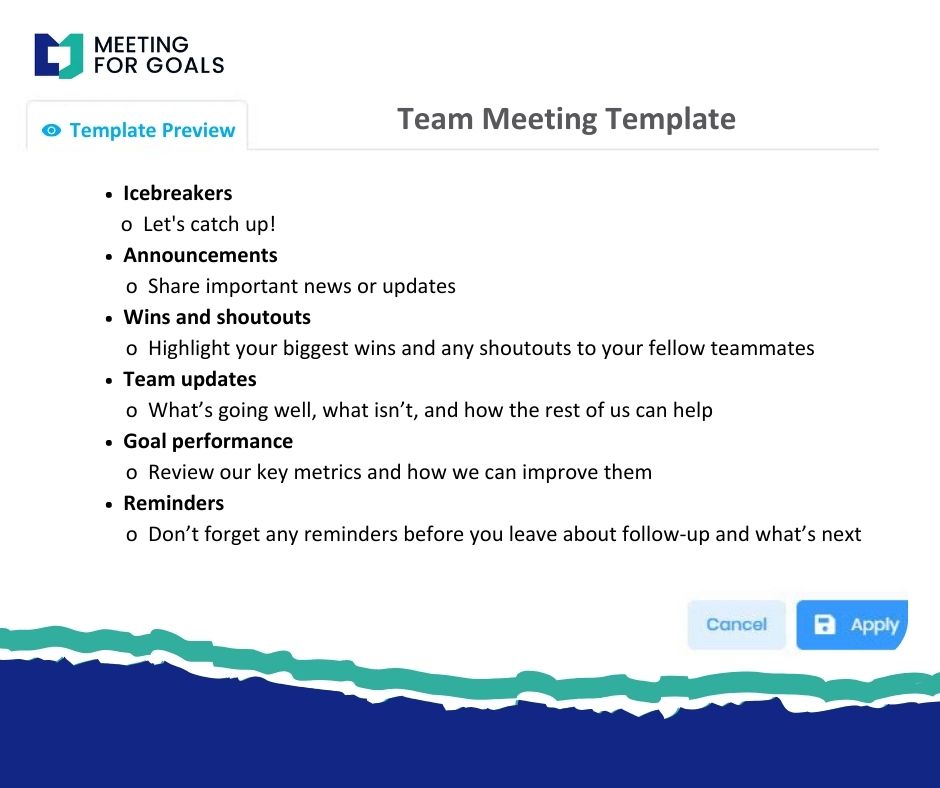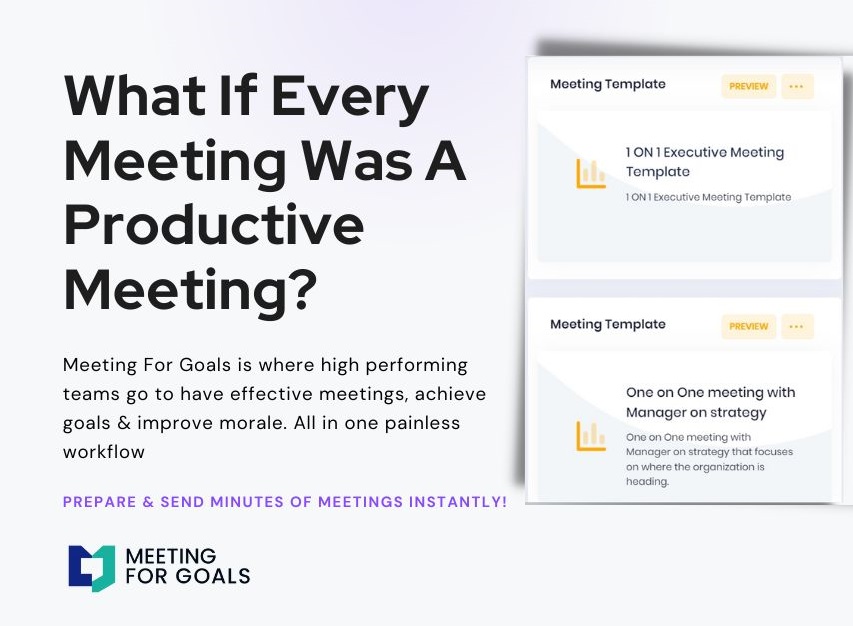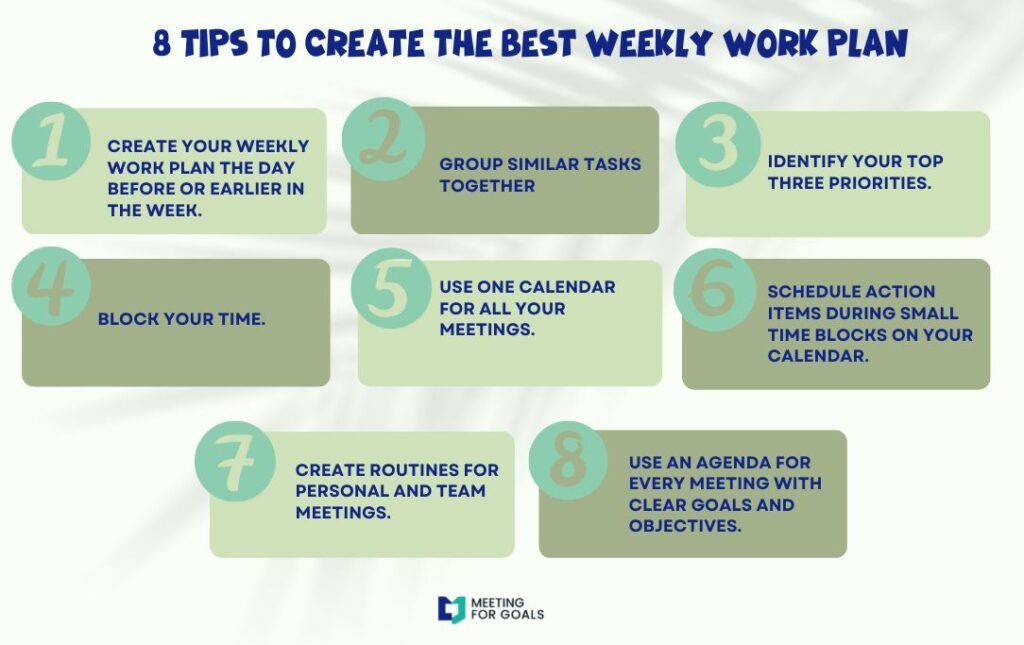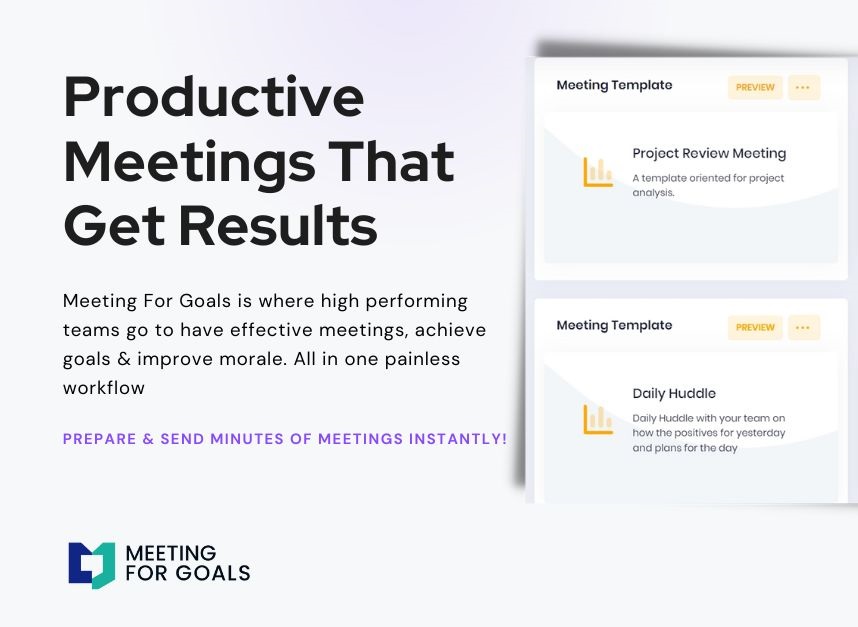In today’s fast-paced business world, meetings are more than just calendar events.
In today’s fast-paced business world, meetings are more than just calendar events. They’re where **ideas are born**, **decisions are made**, and **strategies are aligned**. But what happens **after the meeting** often determines whether those ideas and decisions actually lead to results.
That’s where a **follow-up email** comes in. It’s your chance to **reinforce** what was discussed, **clarify responsibilities**, and **keep everyone moving** in the same direction. For **executive leaders** managing teams between 40 to 70 employees, this simple step can make a **massive impact** on productivity and accountability.
At Meeting For Goals, we believe that **effective meetings** don’t end when the video call does. Our meeting management software helps you capture key takeaways and transform them into **actionable next steps**. In this guide, we’ll show you how to write a follow-up email that drives outcomes, keeps your team aligned, and maximizes your meeting ROI.
If you’re ready to take your meetings to the next level, start by **exploring our free meeting templates** or **sign up for Meeting For Goals today**.
Effective Follow-Up Email After a Meeting
2 Minute Video
Watch a 2 minute demo of our meeting management software in action
I. Why Follow-Up Emails Matter More Than You Think
Meetings are critical for **aligning teams** and making decisions. But if there’s no follow-up, even the best meeting can lead to **confusion**, **missed deadlines**, or **forgotten action items**.
A **follow-up email** bridges the gap between discussion and execution. It reinforces **accountability**, provides **clarity**, and keeps your team focused. For executive leaders, it’s also a great way to demonstrate **leadership** and **attention to detail**—qualities that build **trust across departments**.
In companies where **remote work** and **digital communication** are the norm, written follow-ups are even more important. They serve as a record of what was discussed and agreed upon. This is especially valuable for **cross-functional teams** or when working with **external partners**.
Meeting For Goals is built to help you capture all the **important details** during your meetings. From decisions made to tasks assigned, everything is documented in real-time. That means writing a follow-up email becomes less about **remembering** and more about **reinforcing**.
Whether you’re leading a **strategic planning session** or a **quick team huddle**, a follow-up email ensures nothing slips through the cracks. It turns talk into action—and that’s what high-performing teams are all about.
Adding an Agenda
How to add an agenda instantly on Meeting For Goals
II. Timing and Tone: Laying the Groundwork for Effective Follow-Ups
When it comes to follow-up emails, **timing is key**. Send your email within **24 hours** of the meeting. This keeps the conversation fresh and shows your team that you’re serious about follow-through.
If you wait too long, people **forget details**, priorities shift, and momentum is lost. A quick follow-up keeps everyone engaged and on track.
**Tone matters** just as much as timing. You want to be professional, but also approachable. Remember, your goal is to **motivate**, not just inform.
Here are a few quick tips:
- Send your email the same day if possible—especially for shorter meetings.
- Use a warm, respectful tone. Thank your team for their time and input.
- Tailor your language to your audience. A C-level exec might prefer a high-level summary. A project team may need more detail.
- Use bullet points and short paragraphs to make your email easy to scan.
Meeting For Goals makes this process even easier by helping you track **communication preferences** and capture notes as the meeting happens. That means you’re not scrambling to remember who said what or what needs to happen next.
Want to see how Meeting For Goals can streamline your follow-up process? **Sign up today** and start turning meetings into momentum.
III. Key Components of a Follow-Up Email: Keep It Clear and Actionable
A follow-up email isn’t just a nice gesture—it’s a **strategic tool**. To make it effective, structure it clearly and include the right elements. Here’s a breakdown:
- Subject Line That Sets the Stage
Make your subject line specific and clear. This helps your email stand out and tells the reader exactly what to **expect**.
Examples:
- “Next Steps from Marketing Strategy Meeting – April 3”
- “Follow-Up: Q2 Sales Planning Session”
- “Action Items from Product Launch Review”
- A Brief Thank You
Start with a quick thank you. It sets a positive tone and shows appreciation for your team’s time and effort.
Example: “Thank you for your valuable input during today’s meeting. Your insights are helping shape our next steps.”
- Summary of Key Points
Recap the main takeaways. This ensures everyone is on the same page and helps reinforce the meeting’s purpose.
Include:
- Major decisions made
- Problems discussed
- Opportunities identified
- Strategic shifts or agreements
- Action Items and Next Steps
This is the heart of your follow-up. Clearly list what needs to happen, who’s responsible, and when it’s due.
Example:
- Lisa to finalize the client proposal by April 10
- Mark to coordinate with IT on software rollout by April 14
- Jenna to prepare the Q3 budget draft by April 12
Meeting For Goals lets you assign these tasks during the meeting and automatically includes them in your follow-up. **No extra steps required**.
- Invite Feedback or Questions
Encourage your team to speak up if they’re unclear or have suggestions. This keeps communication open and prevents misalignment.
Example: “If you have any questions or need clarification on your tasks, feel free to reply or reach out directly.”
- Positive Closing
End on a high note. Reaffirm your confidence in the team and express enthusiasm for the work ahead.
Example: “Looking forward to seeing these initiatives move forward. Thanks again for your collaboration!”
With this structure, your follow-up email becomes more than a recap—it becomes a **roadmap for action**.
IV. Crafting Actionable Next Steps: From Talk to Traction
The most important part of your follow-up email? **Clear, actionable next steps**.
Without them, your meeting is just another conversation. With them, it becomes a **launchpad for progress**.
Here’s how to make your action items count:
- Be Clear and Specific
Avoid vague phrases like “Work on the campaign.” Instead, say: “Create a draft of the Q2 campaign brief and send for review by April 7.”
- Assign Responsibility
Make sure every task has a clear owner. This eliminates confusion and ensures accountability.
Example: “Ahmed (Marketing Lead) to review social media metrics and prepare insights by April 5.”
- Set Deadlines
Deadlines create urgency and help with planning. Even if it’s a **soft deadline**, having a target date keeps things moving.
- Connect to Bigger Goals
Tie each task to a broader objective. This shows your team the **“why”** behind the work.
Example: “Updating the onboarding process supports our Q2 goal of reducing new hire turnover.”
- Track Progress
This is where Meeting For Goals really shines. You can assign tasks, set deadlines, and monitor progress—all in one place. Plus, **automatic reminders** keep everyone on track without extra emails.
Want to see how it works? Explore our **free meeting templates** and see how easy it is to get started.
V. Keep the Conversation Going: Follow-Up Is Just the Beginning
Your follow-up email isn’t the end of the communication—it’s the **beginning of a continuous dialogue**.
Here’s how to keep things moving:
- Encourage Feedback
Invite your team to share questions, concerns, or ideas. This shows you value their input and helps catch issues early.
Example: “Please let me know if anything needs clarification or if you have suggestions on how to improve the plan.”
- Schedule Check-Ins
For bigger projects, set up regular check-ins. A **15-minute sync** can keep everyone aligned and address roadblocks quickly.
Use Meeting For Goals to schedule these **automatically** and integrate them into your team’s calendar.
- Use Collaboration Tools
Keep all communication, files, and updates in one place. Meeting For Goals allows team members to comment on tasks, tag colleagues, and upload documents—so nothing gets lost.
- Promote Peer Accountability
Encourage team members to check in with each other. This builds a culture of support and shared responsibility.
- Monitor Engagement
If someone isn’t following through, check in privately. Use data from Meeting For Goals to identify bottlenecks and offer support.
Ongoing communication is the **glue** that holds projects together. It builds trust, prevents misunderstandings, and keeps your team agile.
VI. Conclusion: Turn Every Meeting into Measurable Progress
Meetings are only as valuable as the actions they generate. A **thoughtful follow-up email** ensures that your team doesn’t just talk about goals—they achieve them.
Let’s recap the essentials:
- Send your follow-up email within **24 hours**
- Use a tone that’s both **professional and approachable**
- Include a clear subject line, thank-you note, summary, action items, and a closing
- Define specific tasks with **owners and deadlines**
- Encourage **ongoing communication** and collaboration
With Meeting For Goals, you can automate much of this process. From capturing meeting notes to tracking tasks, our platform helps you stay organized, aligned, and productive.
Ready to make every meeting count? **Sign up for Meeting For Goals now** or explore our library of **free meeting templates** to get started.
**Helpful Resources**
Want to dive deeper into post-meeting productivity? Check out this article from **Harvard Business Review** on **How to Make Your One-on-One Meetings More Effective** and this guide from **Asana** on **How to Write a Follow-Up Email After a Meeting**.
Whether you’re leading a sales team, managing product development, or steering company strategy, Meeting For Goals gives you the tools to turn conversations into **concrete results**.
Start transforming your meetings today at https://meetingforgoals.com.
Word Count: 2,105 words
SEO Keywords: follow-up email after meeting, effective meeting follow-up, meeting action items, post-meeting communication, meeting productivity tools, Meeting For Goals software, team accountability, executive meeting management, goal alignment, follow-up email structure
Meta Description: Learn how to write an **effective follow-up email** after a meeting with this detailed guide for executive leaders. Discover best practices and how Meeting For Goals software enhances post-meeting productivity.




